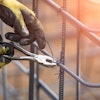
Recently, we discussed three things that the $1.2 trillion bipartisan infrastructure plan, the Infrastructure Investment and Jobs Act (IIJA), should help address. Our roads, bridges, airports, waterways and connected infrastructure will receive $550 billion in new infrastructure spending over the next five years, giving each sector a much needed boost.
But is it enough? Many say no.
The plan's passage though the Senate was a great compromise for our lawmakers in Washington and will be a huge win for the construction industry if passed by the House. It spreads some money over vast areas of the federal government, but in doing so doesn't invest anywhere in a truly meaningful way.
For example, the bill includes huge increases in rail, to the tune of $66 billion, but not enough to install high-speed rail across the country. It increases investment in water (at $55 billion) but that’s not enough to fully upgrade all our out-dated systems.
The overall package includes $40 billion in dedicated resources for bridge repair, replacement and rehabilitation, which is the single largest dedicated bridge investment since the construction of the interstate highway system BUT a recent estimate for the nation’s backlog of bridge repair needs is $125 billion, well over the funds allotted in this plan.
If you look at funding alone, there’s just not enough. Here are a few other things the bill missed out on addressing.
Highway Trust Fund issues not solved
Established in 1956, the Highway Trust Fund (HTF) uses the federally established gas tax to help fund our nation's roads, bridges and highways. Each time you fill up your gas tank, you are helping to pay for the roads you're using. In fact, roughly 51% of road and bridge projects in the United States are funded through the use of the HTF.
The issue with this driver funded program however, is that the current gas tax hasn't been raised since 1993 and the user fee has not been indexed for inflation. So the federal government has borrowed to foot the bill. Add to that the fact that cars are increasing in fuel economy and consumers are leaning more toward hybrid vehicles, and we're talking big trouble for infrastructure funding.
There were high hopes that the bipartisan plan would fix the HTF solvency issue, but they failed to do so. It does include reauthorization of the HTF and a $118 billion bailout from the Treasury’s general fund to meet the needs of the nation’s highways, bringing the grand total of transfers to the HTF to $271.8 billion since 2008, according to Jeff Davis of the nonpartisan Eno Center for Transportation.
The bill does include a pilot program on a gas tax alternative that would charge users based on vehicle miles traveled. But for the most part, Congress has punted the user fee issue yet again when they had a real opportunity to create a longterm fix.
Keep in mind on the HTF, current funding for federal highway and public transportation programs expires September 30. House action on the Senate-passed infrastructure measure would enable a new, five-year reauthorization of current programs to be signed into law by the President by that day.
Workforce development is missing
President Biden has been quoted as saying this bill will create millions of good union jobs all across the country in cities, small towns, rural and Tribal communities and has said that 90% of the jobs created will not require a college degree. In fact, the White House says 2 million jobs per year on average are projected to be added over the next decade as a result of this legislation.
The problem is, who will do the work? In the construction industry alone, second quarter data from the U.S. Chamber of Commerce Commercial Construction showed that 88% of contractors are having difficulty finding workers, forcing them to pull back on projects. Of those who reported difficulty finding skilled labor, 35% have turned down work because of skilled labor shortages. If we don’t have the workers, how can we move these projects forward?
Earlier this year, President Biden proposed the American Jobs Plan which included $100 billion to fund priorities like expanding registered apprenticeships and pre-apprenticeships, particularly for women and people of color, wraparound support for dislocated workers, sector-based training programs focused on target industries and job training for justice-involved individuals. Unfortunately, the bipartisan agreement left this funding out.
Without an investment in workforce development and policy, employers will struggle to find the qualified workers needed to fill infrastructure, clean energy and other in-demand jobs now and in the coming years.
An analysis by the Georgetown University Center on Education and the Workforce finds that in a $1.2 trillion infrastructure plan, more than half of the jobs created will require some form of short-term training, and the remainder will require six months to two years of training. While many workers already have the skills to do these jobs, they may still lack the credentials to prove it– and employers and the workforce system lack the ability to identify these workers at scale. Millions more workers will need to develop their skills and the plan as it stands misses the opportunity to help.
Fix the old or build new?
In March, U.S. Secretary of Transportation Pete Buttigieg emphasized a top priority for his national agenda: Fixing the country’s “maintenance backlog.”
The nation faces an enormous road repair backlog, to the tune of $420 billion, yet the IIJA unfortunately does not include a “fix it first” provision. Despite attempts to include one via amendments, this bill misses an opportunity to prioritize highway maintenance and safety upgrades over expansion or adding new lane miles. A new bridge repair program (Section 11118) represents the sole source of funding dedicated to maintenance.
The bill’s authorization for the main federal-aid highway programs would be $52.5 billion in FY 2022, increased 2% each year until it reaches $56.8 billion in FY 2026. These funds will go a long way to address the $1.2 trillion,10-year, funding gap that ASCE identified in the 2021 Report Card, but it’s not enough.
A November 2019 report by the Federal Highway Administration says doing all highway work deemed as cost beneficial would cost nearly $136 billion per year.
It’s clear there is nowhere near enough money to clear the maintenance backlog, let alone build new roads. Yet the National Association of City Transportation Officials says that this bill allows for “unchecked highway expansion” instead of fixing what we already have.
With the bill being debated in the House this week, there is an opportunity to strengthen the legislation to make it more complete for the industry and the country.
What’s next?
The House Rules Committee is scheduled to meet Aug. 23 to determine the conditions of debate on the IIJA. Members will also set terms for consideration of a separate $3.5 trillion antipoverty and climate budget reconciliation package that House Speaker Nancy Pelosi (D-CA) has said she want to complete before infrastructure is considered. It is unclear whether they can succeed in forcing a vote this week.



















